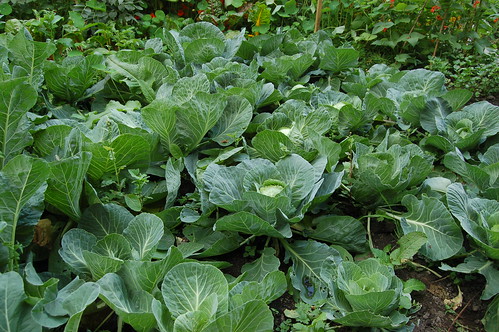We grow our own food in a suburban village in the North East of England. Follow us as we keep up the battle to be self-sufficient.
Saturday 28 August 2010
Unstuffed leaves
I steamed some cabbage leaves to soften them. Into the paella I added from the allotment onions, a shallot and tomatoes. From the supermarket came a bit of chorizo sausage. The cabbage leaves however turned out to be a bit too small for stuffing. The experiment didn't quite work. So, I simply laid them on the plate to make a bed for the rest of the meal (which included some new potatoes - the first of our crop - and home made nasturtium pesto).
How to make nasturtium pesto
Last year we grew nasturtiums on the allotment as a food crop. They have a habit of spreading and smothering everything in sight. This year we didn't plant any but we still have plenty of them! So we have been harvesting nasturtium leaves for use in salads and soups. However, I had been planning to make nasturtium pesto so in this video I have a go at making it.
It turned out to be rather tasty. Our plan had been to use it on some pasta but we decided instead to put it on some boiled new potatoes from the allotment. Very nice!
Beekeeping
During the course, a swarm of bees appeared so we trooped out to watch Mark and Kym capture it.
We also checked out the bee hives.
We hope to start keeping bees next year. Watch this space!
Friday 27 August 2010
How to make strawberry and gooseberry jam
Plenty of strawberries on the allotment this year so we decided one way to use them up was to make strawberry jam. Strawberries however are very low in pectin so to get the jam to set, you need to add fruit that is high in pectin. That normally means adding lemon. This time however we opted for gooseberries. These are high in pectin and are a great complement to strawberries. See the video to see how I got on.
Thursday 26 August 2010
Watch out for cauliflower recipes
Watch out for the forthcoming video on using the cauliflower glut I have been filming. It's not finished yet but I hope to have it on YouTube soon.
How to bottle fruit
Bottling was a common way to preserve fruit before freezers were widespread and in an attempt to keep the skill alive, I taught myself bottling last year. This year we are doing more bottling. Our freezer is full so we have to bottle fruit if we are to stand any chance of preserving it for use over the coming months.
In this video I bottle gooseberries and cherries.
Saturday 21 August 2010
Thinning and cropping
The leaks should have been thinned some time ago but hopefully they will now have space to grow, as will the parsnips. We kept the thinnings. I used the leak leaves and the stems of the onions that had bolted to make vegetable stock. This was then used to make a cauliflower and green leaf summer soup. That's the rather fancy name I have conjured up for this recipe. The idea behind it is that I wanted to use cauliflower leaves rather than throw them away. I'm rather proud of the final result as it was a great soup yet most ingredients would otherwise have been thrown straight onto the compost heap.
I'll post up the recipe shortly.
On a beekeeping course
Our plan is to get bees soon (though probably next year) but we want to learn the ropes before going ahead. Reducing our intake of commercially produced sugar by producing our own honey is a key step towards becoming self-sufficient.
By an amazing coincidence, a swarm of bees was found on the farm this afternoon so we all got kitted up and rushed out to watch it captured and placed in a box to be taken to Northumberland where the Pritchards live and keep their hives.
Friday 20 August 2010
Jam tarts, apple pies and aloo gobi
We still have some jam left from last year and we want to use it up as soon as possible as we need the storage space for this year's preserves. 24 jam tarts barely scratched the surface but they did taste fantastic! I also made an apple pie from the apples I bottled last year. I've not tried it yet so can't comment on its quality. The apples were a bit of a mush as it was not my most successful attempt at bottling fruit (it was also my first attempt so I was learning the hard way!)
I also had a go at making my first aloo gobi today. We still have a load of cauliflowers growing on the allotment so cauliflower recipes are popular reading with us at the moment. If you are interested, our cooking with cauliflowers will be on a YouTube video soon. We've filmed (today) how to make aloo gobi but we will also be filming how to make cauliflower and stilton soup, green leaf soup (using cauliflower leaves) cauliflower cheese and deep fried cauliflower with a dip. There may also be a cauliflower curry coming up soon as well.
Thursday 19 August 2010
Something has been eating our broad beans
Anyone any recipes for mice? I think I will refer to my ancient Roman cookbooks!
Monday 16 August 2010
Bottling, rhubarb, cherries and gooseberries

If like me your freezer is full and you want to try a more traditional way to preserve produce, try bottling it. I first tried bottling fruit last year, learnt from my mistakes and now find it quite straightforward. In the past month I have bottled gooseberries, cherries and rhubarb (admittedly not a fruit but regarded as such by most people).
My mistake last year was to use kilner jars that were too large. Get some kilner jars that are small enough to be completely emmersed in your deepest pan.
Top and tail gooseberries before bottling but don't stone the cherries. Rhubarb should be cut into lengths of less that 2cm. Pack the fruit as tightly as possible into the jars.
Sugar syrup should contain 200-250g of sugar per 600ml of water. Pour the sugar into warm water in a pan and bring to the boil. Leave to boil for a minute then allow to cool slightly (only slightly) before pouring into the fruit filled jars. Seal the jars. If you are using screw top jars do not fully tighten the lid. This is because you will now add the jars to a pan of warm water. Make sure there is a table cloth or a wooden pan stand in the bottom of the pan as the jars could crack or break if they are in contact with the base of the pan when being boiled. Apply heat to the pan. The water should completely cover the jars. The rubber ring in the kilner jars should allow out the pressure during heating. Not fully closing the lids on screw top jars will also allow out the pressure.
Heat the pan to close to boiling point and allow to simmer for a couple of minutes. At that point, they are done.
If you want to use honey instead of sugar, recipes I have seen suggest that is quite workable. As an historian, I guess that using honey has a much longer history for bottling fruit than sugar. So far I haven't used honey as we don't have our hives yet. However, we are going on a beekeeping course soon!
We are planning to use the bottled fruit in pies and desserts later this year.
Break in at the allotment
Then on the allotment this evening our neighbour called round to tell us he had had a break in over the weekend and equipment had been stolen. Alas the route the thieves had used was through our allotment. The hedgerows with the derelict allotment next to ours was cut back by the owner recently with the result that gaps have opened up. So tomorrow we are going to fence off the whole length of if, all 12 metres.
---
Sent via BlackBerry
A good crop of cauliflowers and cabbages
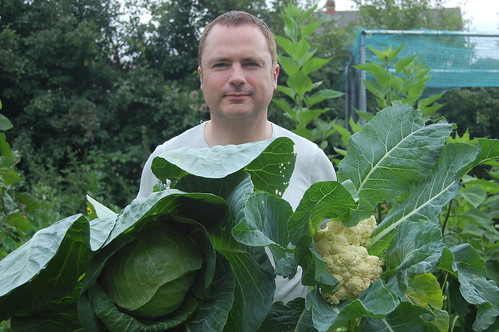
This photo was taken a week ago. The cabbage and cauliflower crops are coming along very well. We are having to pick some of the caulis now before the florettes open out and grow separately. So far we have had cauliflower cheese and caulifloer and stilton soup. I want to have a go at aloo gobi, one of my favourite Indian dishes. I've never made it before but I have eaten it many times. I'm also planning some spices fried cauliflower dipped in a sauce. I'm still hunting recipes for this.
We didn't grow cauliflowers last year and the year before that when we did manage to grow was more an excuse for a crop than the real thing. So we are very pleased with this year's produce.
How to make raspberry and rhubarb jam
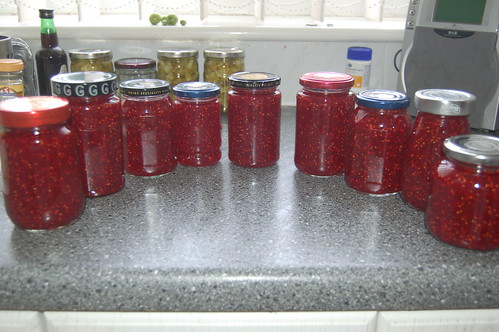
I made this jam last night. It is very easy to make and tastes lovely. The raspberries were picked wild though we are very much at the end of the season (though we have some late summer raspberries growing on the allotment). The rhubarb we grew on the allotment.
What to do:
The ration of raspberries to rhubarb varies according to taste but I used slightly more by weight of raspberries to rhubarb simply because of the quantities I picked (900g of raspberries to 800g of rhubarb).
Chop the rhubarb into lengths of less than 1cm. Add raspberries and rhubarb to the jam pan. Add the juice of two medium lemons for every kg of raspberries and rhubarb. Apply heat. When it boils, leave it simmering until everything has pulped. Then add sugar - same weight of sugar as total of raspberries and rhubarb.
Bring back to the boil and keep boiling until it reaches the setting point. The add to warmed jars.
Saturday 14 August 2010
Watch out for those wild fruit and nut crops
I am on the train from Crystal Palace to Victoria in London at the moment and can see a great crop of blackberries and elderberries along the railway embankments. It is still a couple of weeks to go before we can start picking elderberries back in the North East but the blackberries are beginning to ripen there as well. So be ready with jam and wine making recipes - and pies as well! Try bottling the fruit as well for later use. One of my videos still waiting to be edited is about bottling cherries. Use the same techniques with blackberries. The video should be posted up soon (I may even try to edit on the train to Newcastle this afternoon).
Rowan, or mountain ash, are ripening as well. They are very common though rowan jelly, which is easy to make, is a bit of an acquired taste though it goes well with cold meats.
Apples are also beginning to ripen as well. Check along country lanes in particular. The bad habit of some drivers of irresponsibly tossing their litter from their cars does sometimes result in seeds in discarded apple cores growing into trees. The apples are free for the picking so go get them. Watch out for crab apples as well. They will be ready soon. These are best used in making jellies as they have a good level of pectin. I've never used them for anything else but have set myself the task of finding other uses for them.
Raspberries are still in abundance and you can't beat raspberry jam. Pick them by the bucketload.
Check out old orchards and road verges for pear trees. You will be surprised how many you find. Further south they will be ripening soon. Up north give them a few weeks.
Rosehips are now ready for picking. They can be used in jam making. We are going to dig out wartime recipes for rosehip syrup. Rosehips are very high is vitamin C.
The gooseberry season is probably at an end now but keep your eyes peeled in hedgerows. There may be an odd bush that hasn't given up its bounty yet.
Sloes are just starting to ripen in London. They still need a couple of weeks but get the sloe gin recipes ready. They can also be used in jams and jellies. It will be a bit longer before they ripen up North.
And so on to nuts! Food foragers and those trying to become self-sufficient love hazel nuts. They are the wonder food of the community. They are packed full of protein and oils. Lotties Wood, next to our village of Sunniside in Gateshead, has hazel in abundance. They aren't ready yet but further south they are starting to ripen. Do not hang around before picking them. You will be in an intensive competition with grey squirrels for hazel.
Beechnuts will be ready soon though they tend to elude me. Whenever I pick them they are little more than dried out skins inside the husks. However I am not prepared to give up on them yet.
Acorns will need about another 4 weeks. We use them for making flour. Admittedly you have to be heavily into food foraging and self-sufficiency to do this. I am keen however to look at other ways to use acorns. When I was in the Atlas Mountains in Morocco last year, I heardof people there collecting acorns and cooking them. But I did not witness it first hand and since then my attempts to find anything on the internet has drawn a blank. If anyone can help me on this, I would be eternally grateful.
And finally sweet chestnuts. They aren't ready yet. They probably need at least another month. When they are ready you will need heavy gardening gloves to pick them. As well as roasting them they can be used to make flour for cakes. We've not tried it before as we didn't have enough but we did use them with hazel to make nut roasts. If we get a big enough supply, we will definitely be making flour. We have an eye on a woodland near David's sister's house. I found loads of sweet chestnut trees there at Christmas last year. Too late for picking at the time but this year we are planning an expedition there.
So happy foraging!
---
Sent via BlackBerry
Friday 13 August 2010
How to make cherry vodka
We've been making fruit licquers recently. In this video we make cherry vodka but you can also see our sloe gin and raspberry gin at the end. Before you ask, we used Sainsbury's Basics Vodka. Don't use any expensive brands.
Thursday 12 August 2010
How to pickle gherkins
Gherkins in abundance from the allotment and in this video we pickle some in a sweet pickling vinegar.
Monday 9 August 2010
Coming up
---
Sent via BlackBerry
Disappointing garlic crop
If you are expecting a good garlic crop, one thing we found over the last year was that good storage is important. We hung all our garlic in our garage (nice and cool, little direct light and we don't keep the car in it.) But by the start of this year, we found it was drying out. So, I suggest splitting a good crop. Half to be hung up; the other half stored in olive or cooking oil.
---
Sent via BlackBerry
How to pickle gherkins

The summer glut of gherkins is in full flood so I have put together this recipe for a sweet pickling vinegar to pickle gherkins. I went for sweetness as 2 years ago when we last had a successful gherkin crop we pickled them in ordinary pickling vinegar and found the end result disappointingly sharp.
So here's the recipe for sweet pickling vinegar and how to pickle gherkins.
The first job to do is sprinkle salt on the gherkins and leave them to stand for 24 hours. Then rinse them.
Pack pickling jars or large jam jars with whole gherkins. Slice longways those too large to fit in or where whole gherkins won't fit the space left.
To make one litre of sweet pickling vinegar you will need:
One litre of white wine vinegar
400g sugar
1 tablespoon of mustard seeds
2 teaspoons of celery salt
2 teaspoons of turmeric
one teaspoon ground mace
2 cinammon sticks
1 teaspoon black peppercorns
1 tablespoon of coriander seeds
Put the vinegar into a pan and begin to heat it. Add and stir in the sugar and then add all the spices and seeds. Bring to the boil and simmer for about 10 minutes. (Actually, I say this makes one litre but in reality a bit of the liquid is lost to evaporation.)
Let the vinegar cool but when it is still hot pour onto the gherkins, filling each jar to the brim. Seal and leave for about 6 weeks before starting to use.
Pickles gherkins can keep for quite some time. The ones we pickled 2 years ago are still being used by us, even though we were disappointed at how sharp was the taste. The ones we have pickeld this year however are likely to be used up more quickly.
Below: me with 2 of the 8 jars made in the first batch of pickled gherkins.

We'll soon be doing some pickling recipes with chopped gherkins and cucumbers. Watch this space.
Explosive elderflower champagne
And then overnight 4 of the 30 bottles I made in June decided to fire off their corks in the garage where they are brewing. Most of the bottles have corks rising from the nozzle and are only held in place by the wire cages put on them when they wwere first bottled. I fear however that we will lose more of them before the year is out.
Meanwhile, watch out for forthcoming posts on making red champagne. I first came across red champagne when I was in the Crimea five years ago. I haven't made it before but I guess I can ferment blackberry and elderberry juice in champagne bottles. The later blackberries will be better as they tend to be more juicy but setting it away in October should mean we can be drinking it in time for Christmas.
Christmas potatoes are growing
The potato bags were a good investment. We grow plenty of potatoes on the allotment so the bags are an addition for us. However, for people with no allotment and only a small garden - or indeed no garden at all - potato bags are very useful. They can be used on patios, balconies and flat rooves.
Our greenhouse is too small

I took this photo a couple of weeks ago and since then, the plants inside have grown further. Inside the greenhouse we have 7 varieties of tomatoe as well as aubergines, peppers, chilies, basil and cucumbers. At the moment the cucumbers are cropping prolifically. We are testing recipes this week for relishes and pickles for cucumbers and gherkins so watch this space for forthcoming posts and videos.
The big problem we have is that the greenhouse is simply too small (it's a 6 X 8). We are thinking of using the plots behind the greenhouse for a polly tunnel. We will make a decision on that shortly.
Meanwhile, we are about to be met by a tidalwave of tomatoes. This year for the first time we are also growing beef tomatoes. They are all green at the moment but are already a good size.
Thursday 5 August 2010
Some of our recent pickings

These strawberries will be used in jam making. The plan is to make gooseberry and strawberry jam. Strawberries have very little pectin but gooseberries have more and using them together means we have a jam that sets rather than runs.

Cherries and gooseberries. I've been picking plenty of cherries recently. The red/yellow cherries are very sweet so tomorrow I'll be bottling them. The black cherries have been made into jam. More about that soon. The gooseberries came from our neighbour Vic's garden. There were too many for him to use so we swapped him some jam for the chance to pick his fantastic crop of gooseberries. A pie will also be on his way to Vic shortly (and yes we will be making a video on how to make a gooseberry pie!)

We have gherkins by the bucket load. These ones have now been pickled in sweet spiced vinegar. In the photo you can see they are sprinkled with salt - the start of the pickling process. As will have a video about pickling gherkins coming up shortly. It's already filmed but we haven't edited it yet.
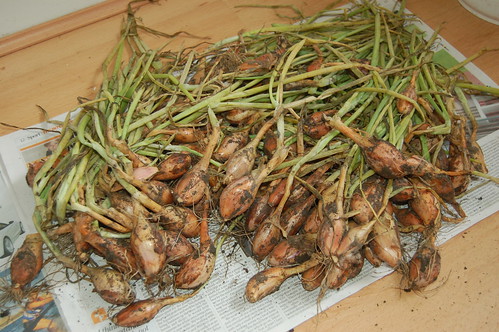
A pile of shallots. This is the first time we have grown them and we had a good crop.
Cherry Vodka

Above: the recently bottled vodka. Below, the pickled cherries which will be used as toppings or in pies and trifles.

Sunday 1 August 2010
An update on bed 1
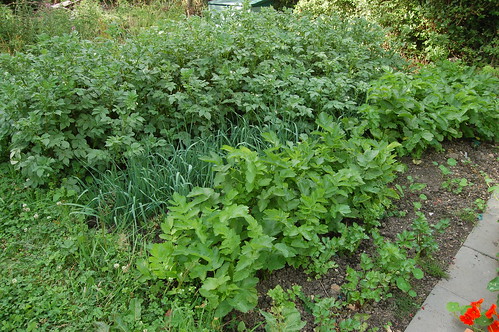
This is bed 1, taken last week. This is the oldest bed on the allotment - so this is the 3rd year we have had crops from it. Top left to bottom right: potatoes, leeks, parsnipsa and celeriac.
The leeks will need thinning, a job I've lined myself up for over the coming few days. The thinnings will be eaten as baby leeks.
Notice the nasturtiums in the bottom right of the picture? We keep having to strip them away from the path. Almost as quickly as we chop them back, they have grown to fill the space. We tolerate them on bed 2 where they grow between the broad beans and don't cause too many problems. If they get onto bed 1, they will smother everything.
Cabbage patch
Sweetcorn

The sweetcorn we planted on bed 3 is coming along very well. We have 26 plants growing and we have now found corn cobbs beginning to develop. We grew sweetcorn last year but the results were at best modest. Hopefully this year we are heading for something more substantial.
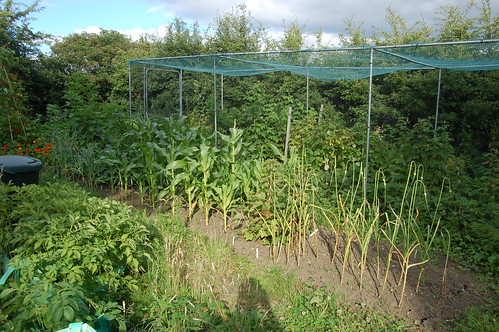
This is bed 3 where the sweetcorn is growing (towards the left of the picture). It shares the bed with garlic, Jerusalem artichokes, courgettes, a blackcurrant bush and shallots, though the latter have now been harvested.
Summer fruit jam
900g strawberries
400g raspberries
400g red currants
All the fruit was added to the jam pan and heat was applied. When it has all pulped down, add in 1.7kg of sugar (ie the same weight of sugar as fruit) and then bring back to the boil. Keep boiling for a few minutes until it has reached the setting point (to test it has, put a spoonful on a plate and leave it to stand for a couple of minutes. If it develops a skin, it has reached setting point.)
This jam is a lovely mix and has a fantastic red colour.

At this point the fruit is beginning to pulp down.
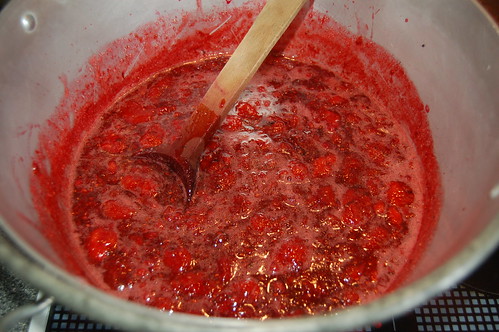
(At this point the fruit has turned to a lovely red coloured mixture.)
Enjoying a sloe gin
One wild crop that has been very successful this year is cherries. Councils love to plant cherry trees because they look pretty in the spring when covered by blossom. My interest is the fruit that starts to ripen in June. Last year, the crop was largely gone by the start of July. I had been in Iceland in the last week of June 2009 filming geysers and waterfalls. My plan had been to pick cherries on my return. And on my return, I found all the cherries had gone. This year they just keep on coming. Bucket loads of them. I was out again this afternoon picking cherries. I have already made cherry jam. More jam will be made tomorrow and I'm planning some cherry fruit leathers. Watch this space (the cherry jam video will be filmed tomorrow).
Today I also picked a bucketful of gooseberries. Our neighbour Vic told us there were too many for his own use so invited us to pick the fruit in his back garden. One of the jams I will make is strawberry and gooseberry. The advantage with this mix is that gooseberries have pectin, strawberries don't. The combination will set. And we have plenty of strawberries on the allotment. Watch out as well for some of the gooseberry pies we will be making soon.
---
Sent via BlackBerry
